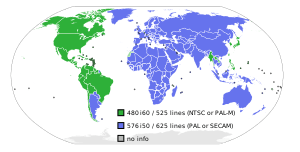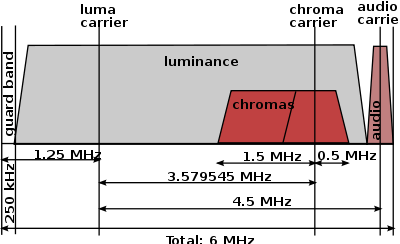CCIR System M

CCIR (or FCC) System M, sometimes called 525 line, is the analog broadcast television system used in the United States since July 1, 1941, and also in most of the Americas and Caribbean, South Korea, and Taiwan. Japan uses System J, which is nearly identical to System M. The systems were given their letter designations in the ITU identification scheme adopted in Stockholm in 1961. Both System M and System J display 525 lines of video at 30 frames per second using 6 MHz spacing between channel numbers, and is used for both VHF and UHF channels.
Currently (as of 2015), System M and J is being replaced by digital broadcasting such as the Americas, Japan, South Korea, Taiwan and the Philippines.
Specifications

| System | Lines | Frame rate | Channel b/w | Visual b/w | Sound offset | Vestigial sideband | Vision mod. | Sound mod. | Notes |
|---|---|---|---|---|---|---|---|---|---|
| J | 525 | 30 (29.97 NTSC) | 6 | 4.2 | +4.5 | 0.75 | neg. | FM | Japan (NTSC-J) |
| M | 525 | 30 (29.97 NTSC) | 6 | 4.2 | +4.5 | 0.75 | neg. | FM | Most of the Americas and Caribbean; Myanmar, Philippines, South Korea, Taiwan (all NTSC-M) Brazil (PAL-M) |
Color standards
NTSC-M and NTSC-J
Strictly speaking, System M does not designate how color is transmitted. However, in nearly every System M country, NTSC is used for color television, a combination called NTSC-M, but usually referred to more recently as simply "NTSC" because of the relative lack of importance of black-and-white television. In NTSC-M and Japan's NTSC-J, the frame rate is offset slightly, becoming 30⁄1.001 frames per second, usually labeled as the rounded number 29.97.
PAL
The main exception to NTSC is Brazil, where PAL color is used instead, resulting in the PAL-M combination unique to that country, which is monochrome-compatible with other System M countries, but not compatible with other PAL countries, which use different basic systems as their base. PAL-M signals are at 30 frames per second instead of slowing down to 29.97 like NTSC.
See also
- NTSC — dominant color system used with System M, so much so that System M is often referred to as "NTSC". Much of the information in the NTSC article is actually about System M.
- Broadcast television systems — explains other types of television system standards
- Multichannel television sound — usual method for adding stereo to System M audio
